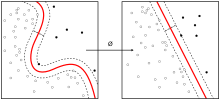U-Net
| Machine learning and data mining |
|---|
 |
|
Machine-learning venues |
|
The U-Net is a convolutional neural network that was developed for biomedical image segmentation at the Computer Science Department of the University of Freiburg, Germany.[1] The network is based on the fully convolutional network [2] and its architecture was modified and extended to work with fewer training images and to yield more precise segmentations.
Network architecture
The network consists of a contracting path and an expansive path, which gives it the u-shaped architecture. The contracting path is a typical convolutional network that consists of repeated application of convolutions, each followed by a rectified linear unit (ReLU) and a max pooling operation. During the contraction, the spatial information is reduced while feature information is increased. The expansive pathway combines the feature and spatial information through a sequence of up-convolutions and concatenations with high-resolution features from the contracting path.[3]
The basic articles on the system [1] [2] have been cited 1638 and 1086 times respectively on Google Scholar as of May 19, 2018[4]
References
- 1 2 Ronneberger, Olaf; Fischer, Philipp; Brox, Thomas (2015). "U-Net: Convolutional Networks for Biomedical Image Segmentation". arXiv:1505.04597 [cs.CV].
- 1 2 Long, J.; Shelhamer, E.; Darrell, T. (2014). "Fully convolutional networks for semantic segmentation". arXiv:1411.4038 [cs.CV].
- ↑ "U-Net code".
- ↑ Google Scholar citation data